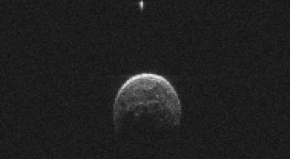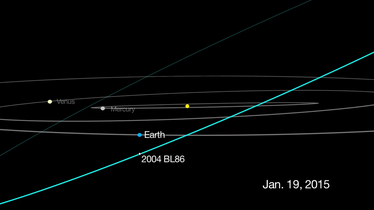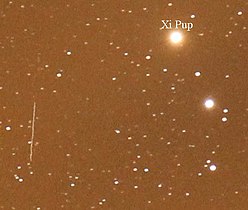 | |
| Discovery [1] [2] | |
|---|---|
| Discovered by | LINEAR |
| Discovery site | Lincoln Lab's ETS |
| Discovery date | 30 January 2004 |
| Designations | |
| (357439) 2004 BL86 | |
| NEO · PHA · Apollo [1] [3] | |
| Orbital characteristics [1] | |
| Epoch 4 September 2017 ( JD 2458000.5) | |
| Uncertainty parameter 0 | |
| Observation arc | 4,863 d (13.31 yr) |
| Aphelion | 2.1070 AU |
| Perihelion | 0.8974 AU |
| 1.5022 AU | |
| Eccentricity | 0.4026 |
| 673 d (1.84 yr) | |
| 169.27 ° | |
| 0° 32m 7.08s / day | |
| Inclination | 23.775° |
| 126.69° | |
| 311.45° | |
| Known satellites | 1 [4] [5] |
| Earth MOID | 0.0092 AU (3.6 LD) |
| Physical characteristics | |
Mean diameter | 0.263±0.026 km
[6] 0.290±0.030 km [7] 0.325±0.025 km [5] [a] |
| 2.620±0.001
h
[6] 2.6205±0.0003 h [8] 2.637±0.024 h [7] | |
| 0.40
[7] 0.40±0.08 [6] | |
| V [7] [9] [10] | |
| 19.05
[9] 19.3 [1] [7] 19.51±0.02 [6] | |
(357439) 2004 BL86 is a bright sub-kilometer asteroid and binary system, classified as near-Earth object and potentially hazardous asteroid of the Apollo group, approximately 300 meters (980 ft) in diameter. It was discovered on 30 January 2004 by astronomers of the Lincoln Near-Earth Asteroid Research at Lincoln Laboratory's Experimental Test Site near Socorro, New Mexico. [3] Its 70-meter (200 ft) moon was discovered during the asteroid's close approach to the Earth in January 2015. [4] [5]
2015 Earth approach
On 26 January 2015 at 16:20 UTC, 2004 BL86 passed 1,199,600 km (745,400 mi), or 3.1 lunar distances, from Earth. [11] The asteroid briefly peaked around apparent magnitude 9 and was near the celestial equator. [12] The asteroid was visible in telescopes with objectives of 100 mm (4 in) or larger; high-end binoculars under a dark sky may also have worked. [13] Near closest approach the asteroid was moving about 2.5 degrees per hour (2.5 arcseconds per second). [12] [14] The asteroid came to opposition (furthest elongation in the sky from the Sun) on 27 January 2015 at 04:37 UTC. [12] Around 5:00 UTC, the asteroid was near M44 (the Beehive Cluster). [14]
The 26 January 2015 approach of 3.1 lunar distances was the closest approach of 2004 BL86 for at least the next 200 years. [11] [15] For comparison, 2015 TB145, about twice the size of 2004 BL86, passed 486,800 km (302,500 mi), or 1.3 lunar distances, from Earth on 31 October 2015. [16]
Satellite
A minor-planet moon, provisionally designated S/2015 (357439) 1, was first detected by ground-based telescopes by Joe Pollock and Petr Pravec. [8] [17] Observations by the Goldstone Deep Space Communications Complex and Green Bank Telescope confirmed that it is a binary asteroid with a secondary roughly 70 meters (200 ft) across. [5] The secondary is estimated to orbit at least 500 meters (1,600 ft) from the primary. [4] About 16% of asteroids over 200 meters (660 ft) in diameter are thought to be binaries. [5]
Numbering and naming
This minor planet was numbered on 27 March 2013 ( M.P.C. 83151). [18] As of 2020, it has not been named. [3]
Gallery
-
Animation of 2004 BL86's orbit
Sun · Earth · 2004 BL86 -
2004 BL86 safely passes Earth on 26 January 2015
-
Trajectory of 2004 BL86 during Earth close approach
Notes
References
- ^ a b c d "JPL Small-Body Database Browser: 357439 (2004 BL86)" (2017-05-24 last obs.). Jet Propulsion Laboratory. Retrieved 29 November 2017.
- ^ "MPEC 2004-B80 : 2004 BL86". IAU Minor Planet Center. 31 January 2004. Retrieved 7 June 2014. (K04B86L)
- ^ a b c "357439 (2004 BL86)". Minor Planet Center. Retrieved 30 September 2020.
- ^ a b c Johnston, Wm. Robert (31 January 2015). "Asteroids with Satellites Database – (357439) 2004 BL86". Johnston's Archive. Retrieved 29 November 2017.
- ^ a b c d e Agle, D. C. (26 January 2015). "Asteroid That Flew Past Earth Today Has Moon". NASA/Jet Propulsion Laboratory. Retrieved 29 November 2017.
- ^ a b c d Reddy, Vishnu; et al. (September 2015). "The Physical Characterization of the Potentially Hazardous Asteroid 2004 BL86: A Fragment of a Differentiated Asteroid". The Astrophysical Journal. 811 (1): 10. arXiv: 1509.07122. Bibcode: 2015ApJ...811...65R. doi: 10.1088/0004-637X/811/1/65. S2CID 119260041.
- ^ a b c d e Birlan, M.; et al. (September 2015). "Characterization of (357439) 2004 BL86 on its close approach to Earth in 2015". Astronomy and Astrophysics. 581: 7. Bibcode: 2015A&A...581A...3B. doi: 10.1051/0004-6361/201526460.
- ^ a b c Pollock, J.; Pravec, P.; Oey, J.; Reichart, D. E.; Haislip, J. B.; LaCluyze, A. P. (January 2015). "(357439) 2004 BL_86". Central Bureau Electronic Telegrams. 4063 (4063): 1. Bibcode: 2015CBET.4063....1P.
- ^ a b "LCDB Data for (357439)". Asteroid Lightcurve Database (LCDB). Retrieved 29 November 2017.
- ^ Franco, Lorenzo (July 2015). "Low Resolution Visible Reflectance Spectrum for NEA (357439) 2004 BL86". The Minor Planet Bulletin. 42 (3): 186–187. Bibcode: 2015MPBu...42..186F. ISSN 1052-8091.
- ^ a b "JPL Close-Approach Data: 357439 (2004 BL86)" (last observation: 12 March 2013; arc: 9.11 years). NASA/Jet Propulsion Laboratory. Retrieved 7 June 2014.
- ^ a b c "(357439) 2004BL86 Ephemerides for 25 January 2015 through 29 January 2015". NEODyS. Retrieved 7 June 2014.
- ^ Musgrave, Ian (23 January 2015). "Seeing the Close Flyby of NEO 2004 BL86 26 - 27 January, 2015". Retrieved 28 January 2015.
- ^ a b MacRobert, Alan (22 January 2015). "Mountain-size Asteroid Glides Past Earth". Sky & Telescope. Retrieved 23 January 2015.
- ^ Busch, Michael (7 February 2015). "Final post-flyby update..." Twitter.com. Retrieved 7 February 2015.
- ^ "JPL Close-Approach Data: 2015 TB145" (last observation: 1 November 2015; arc: 22 days). NASA/Jet Propulsion Laboratory. Retrieved 2 December 2015.
- ^ "Image Release: High-Def Radar Images of Near-Earth Asteroid". National Radio Astronomy Observatory. 30 January 2015. Retrieved 30 January 2015.
- ^ "MPC/MPO/MPS Archive". Minor Planet Center. Retrieved 29 November 2017.
External links
- Asteroids with Satellites, Robert Johnston, johnstonsarchive.net
- PSI Scientists Study Surface Composition of Asteroid 2004 BL86 During Close Flyby of Earth, Planetary Science Institute, 27 January 2015
- Asteroid Lightcurve Database (LCDB), query form ( info Archived 16 December 2017 at the Wayback Machine)
- (357439) 2004 BL86 at NeoDyS-2, Near Earth Objects—Dynamic Site
- (357439) 2004 BL86 at ESA– space situational awareness
- (357439) 2004 BL86 at the JPL Small-Body Database






